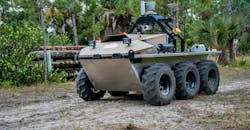Army’s Robotic Research Seeks Mechanical Partners
Robotic soldiers and autonomous military vehicles will one day populate the battlefield, and that day grows closer quickly thanks to efforts by the U.S. Army Research Laboratory (ARL) over the past decade. In particular, the Combat Capabilities Development Command (CCDC) of the ARL has worked closely with industrial and academic partners on the development of robotic autonomous vehicles capable of serving as trusted teammates during times of conflict, showcasing some of the advanced robotic technologies recently at the National Robotics Engineering Center in Pittsburgh.
U.S. Army CCDC ARL Director Dr. Philip Perconti looks back over the 10 years of robotics research: “Ten years ago, Feb. 2009, the Army Research Laboratory issued a program announcement with the goal of bringing together industrial, government, and academic institutions to address research and development required to enable the development and deployment of future unmanned military ground vehicle systems ranging in size from man-portables to ground combat vehicles. This is what started the Robotics Collaborative Technology Alliance.”
Much of the work involves the modernization of autonomous vehicles based on the availability of advanced electronic hardware and software, for example to better handle rough terrain and quickly changing environmental conditions. As the gathering of robotics researchers revealed, battle-ready robotics may come in many different sizes, with different capabilities. Part of robotic research for these autonomous vehicles also involves their capability to collaborate with human partners, operating with artificial intelligence (AI) to aid with problem-solving in the field.
Dr. Stuart Young, the Robotics Collaborative Technology Alliance (RCTA) manager with the CCDC ARL, observed: “We’ve really changed the way we think about robotics over the last 10 years from thinking about robots using a metric world where they’re tools—they really don’t understand the world, they don’t really have the ability to reason about the world and we’ve really started bringing in semantic understanding of the world—which basically means they understand concepts in the same way humans do.”
He added: “If you don't understand in those terms, then it's hard to understand, imagine, or predict what the systems will do.”
The ARL functions as the U.S. Army’s corporate research laboratory. The RCTA combines a group of innovative thinkers within leading industrial firms, universities, and the Army to advance the technologies applied in robotic vehicles and how they might be optimally used on the battlefield. The group includes General Dynamics Land Systems, the Massachusetts Institute of Technology (MIT), Florida State University, and the Robotics Institute of Carnegie Mellon University.
Perconti notes: “I know we have a long way to go before robotics technology is a commonplace as, say, the automobile and devices powered by speech recognition are as intuitive as human beings. But, thanks to the professionalism and dedication of all who have worked for and with the Robotics CTA over the past decade or more, we have taken a significant leap forward to providing unprecedented capabilities for the soldier in our Army.”
About the Author
Jack Browne
Technical Contributor
Jack Browne, Technical Contributor, has worked in technical publishing for over 30 years. He managed the content and production of three technical journals while at the American Institute of Physics, including Medical Physics and the Journal of Vacuum Science & Technology. He has been a Publisher and Editor for Penton Media, started the firm’s Wireless Symposium & Exhibition trade show in 1993, and currently serves as Technical Contributor for that company's Microwaves & RF magazine. Browne, who holds a BS in Mathematics from City College of New York and BA degrees in English and Philosophy from Fordham University, is a member of the IEEE.

